Every West Ham United supporter remembers their infamous 2002-03 season when the maxim ‘too good to go down’ was (briefly and uniquely) disproven, triggering two decades of misplaced anxiety for any Premier League club flirting with the bottom three beyond the midway point.
In reality the financial disparities in modern football ensure you really can be too good to go down. But it would be fitting if this West Ham team – so eerily similar to the side of 20 years ago – broke the mould.
In 2002-03 Glenn Roeder, a defensively cautious manager and dreary pragmatist, had high hopes after finishing seventh the year before only for his tactical stylings to clip the wings of a talented squad (Paulo Di Canio, Jermaine Defoe, Joe Cole, Michael Carrick, Frédéric Kanouté, David James, Glen Johnson) and leave West Ham battling relegation. Sound familiar?
But the comparison between that team and this current one is not necessarily ominous. Back in 2003-03, West Ham rallied to win 22 points from their final 11 games and were desperately unlucky to go down with a still-record 42 points. A similar run this season will almost certainly have a better outcome.
There are hints, however small, of David Moyes overcoming his defensive instincts and embracing a more progressive playing style between now and the end of the season.
Just maybe, West Ham have been a little unlucky. Just maybe, Moyes will be inspired by the UEFA Europa Conference League run to unleash the attacking talent available to him.
Or maybe West Ham are simply falling in on themselves. The data suggests as much.
West Ham’s Shrivelling Defensive Shape
Earlier this month, The Guardian reported that Moyes’s tactics are “causing unease in the dressing room” and that “some players have grown weary of his caution and feel it is holding them back”.
That will chime with any West Ham supporter watching their team drop deeper and shrivel up this season. It chimes with the statistical comparison to last season, too.
West Ham’s style has changed considerably. The headline number is that their average possession has dropped from 47.9% to 43.5%. But their number of 10+ open-play pass sequences are down from 10.0 to 7.4 per game and there is a similar drop in the sequence time of their moves (down from 9.2 to 8.2 seconds). So they are holding possession for shorter periods of time, and completing fewer passes when they do have the ball.
Their build-up attacks – how often they convert a 10+ pass move into a shot or touch in the box – have fallen too (1.81 to 1.27 per game), as have their direct attacks (1.58 to 1.23) which can be viewed as a proxy metric for counter attacks.
Altogether, this paints a picture of a West Ham side attacking more slowly yet with shorter passing sequences – the worst of both worlds:
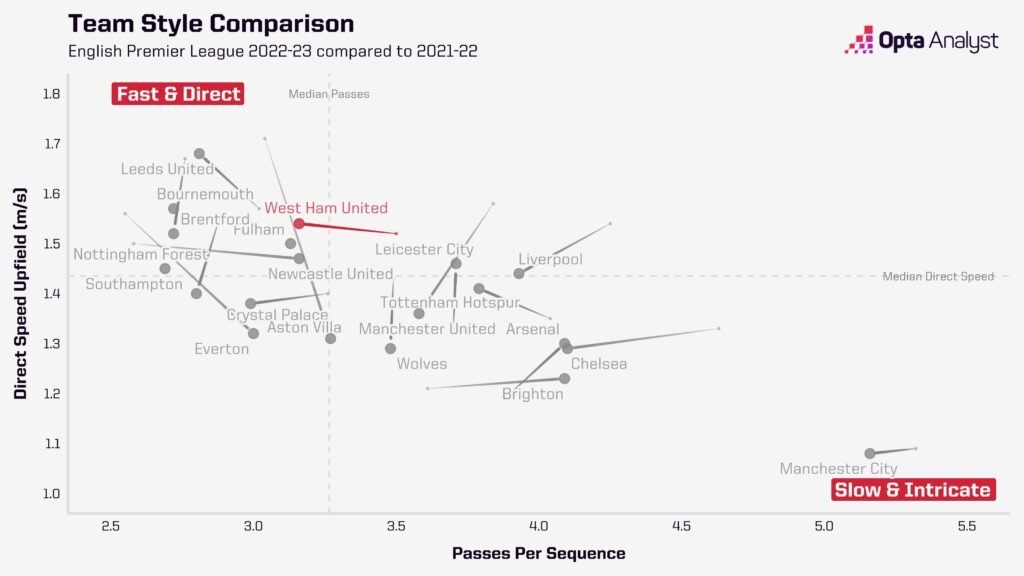
A more conservative setup, with the football starting in deeper areas of the pitch and regularly failing to advance up the field, is evidenced in multiple places. Their goals scored per game is down from 1.6 to 0.9, most likely because they are creating worse quality shots (their average shot distance has risen from 16.6m to 17.8m) due to their cagier style: West Ham’s passes completed per game is down from 377 to 337 and their passes into the penalty area are down from 7.1 to 6.0.
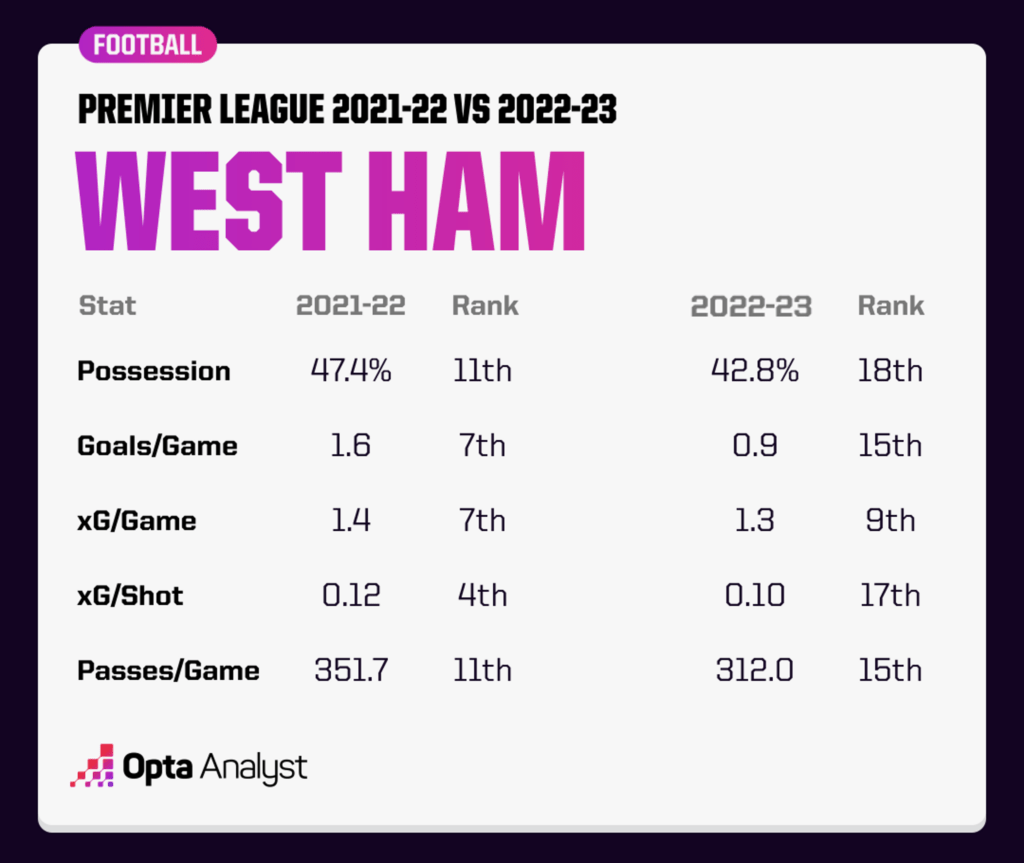
Worse still, they are not even making up for a smaller input in possession by working hard off the ball. Their team pressures have dropped dramatically from 284.4 per match to 169.5 per match, reflecting the passive feel to West Ham’s Premier League performances.
What exactly has happened? It is extremely unlikely that Moyes has instructed his players to be more negative, and in fact has been tasked with integrating more creative footballers into his favoured starting XI this season. Instead, what we are likely witnessing is the natural life cycle of conservative football: eventually players grow weary, and when they do the tactical negativity begins to affect self-esteem, causing a sharp downturn in the creative, proactive, and open-minded thinking required to play well.
More specifically, West Ham’s central midfield has become apathetic. The Hammers are averaging around 40 fewer touches of the ball per match this season and 30 of these are in the middle third of the pitch, while a look at their ‘zones of control’ shows central midfield falling out of their hands:
West Ham Zones of Control: Premier League 2022-23
Tomáš Souček is the worst offender in this regard. His progressive passes are down by 25% from 4.2 to 3.2 per 90, while his total number of attempted passes is down from 39.5 to 32.6 and his average number of touches has dropped from 53.5 to 46.6.
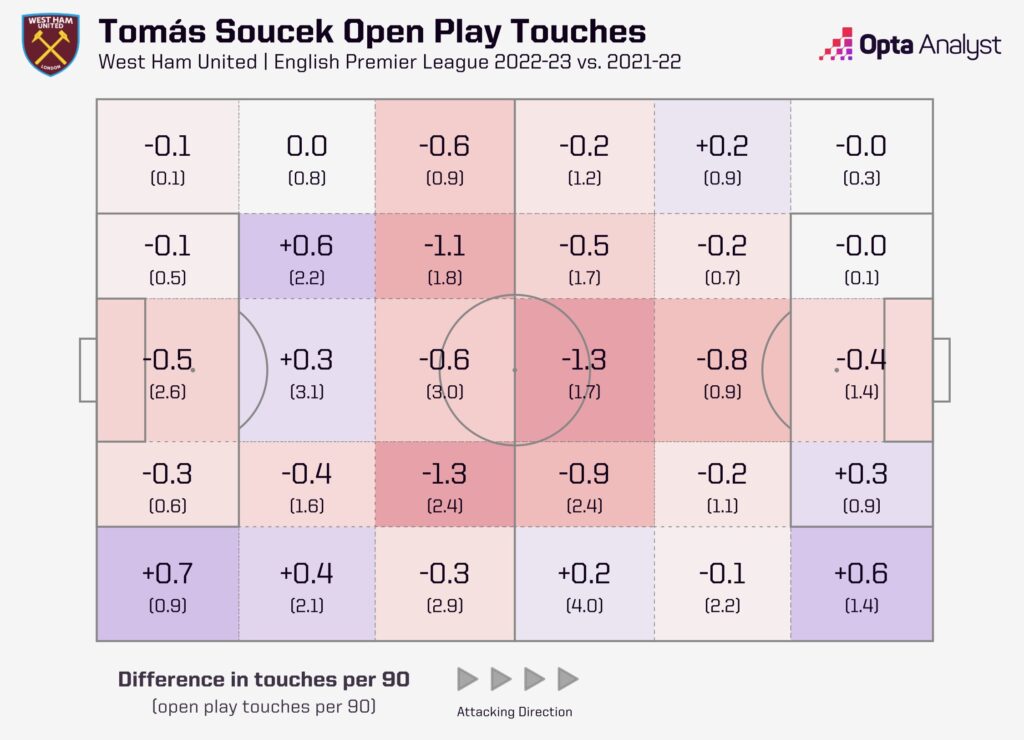
But potentially just as significant has been the role of Lucas Paqueta, struggling to settle under Moyes having been played in many different positions. His progressive carries are down from 2.0 per game at Lyon to 0.7, while his progressive passes received have dropped from 7.3 per match to 2.9 per match. West Ham lack the urgency and verticality that comes from morale as much as Moyes’s tactical preferences.
But Moyes Is Trying to Fix Things…
Then again, we tend to build narrative retrospectively and although the eye test suggests West Ham have gone backwards the margins are slim. With the rub of the green Moyes’s side might have kept their heads held high enough to repeat last year’s performances.
Case in point, their xG for and xG against figures (per 90) are almost identical this year to last: 1.29 for and 1.21 against in 2022-23 compared with 1.35 and 1.41 in 2021-22. Jarrod Bowen scored in line with his xG last season but is on -2.9 this year, while some missed opportunities from Souček (-1.9) helps paint a very different picture to last year, when eight players outscored their xG compared to just one – Gianluca Scamacca – this season. Being unable to finish chances presented to them is arguably the main difference.
Elsewhere, West Ham are swinging in just as many crosses (21.3 per game, up from 21.1), are producing more shot-creating actions (22.7, up from 20.3) and have won more tackles (15.8, up from 13.1). It is a more complicated picture than many have assumed and, more significantly, Moyes does appear to have decided to move to a more attacking setup recently.
In a 4-0 victory over Nottingham Forest last month Moyes deployed a 4-2-3-1 and, unlike in previous incarnations of this formation used in November, Paqueta was given a more advanced – and free – role as a number ten. Note the difference between his positioning in this game compared to the last time Moyes used this formation, a 1-0 defeat to Wolves:
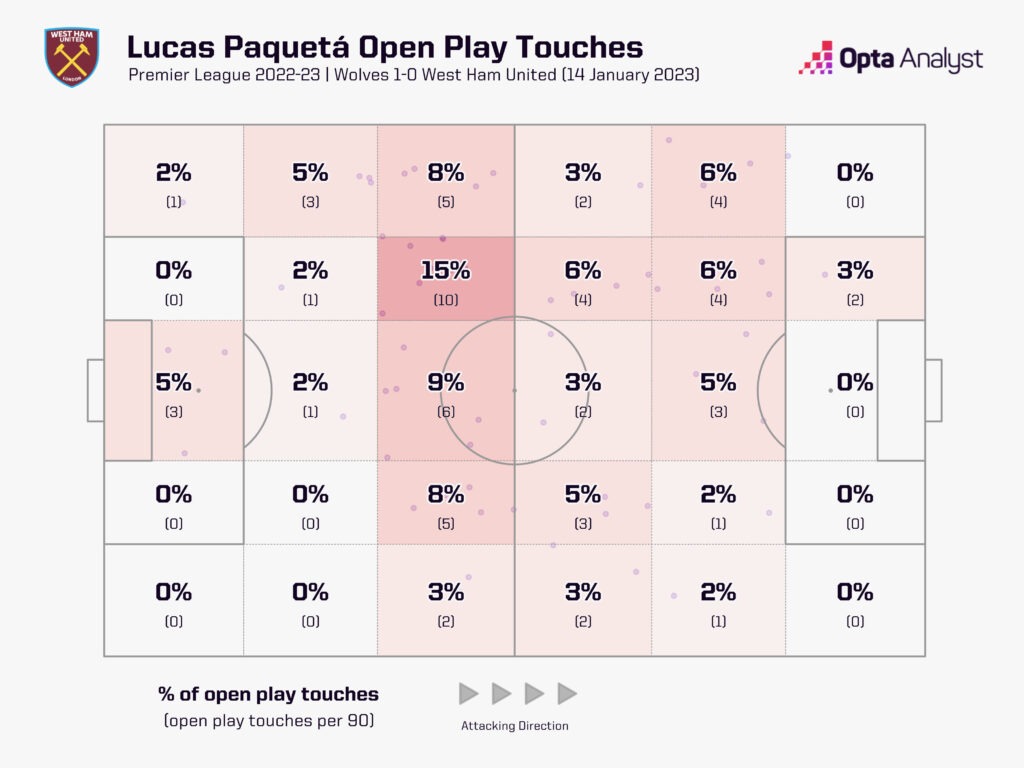
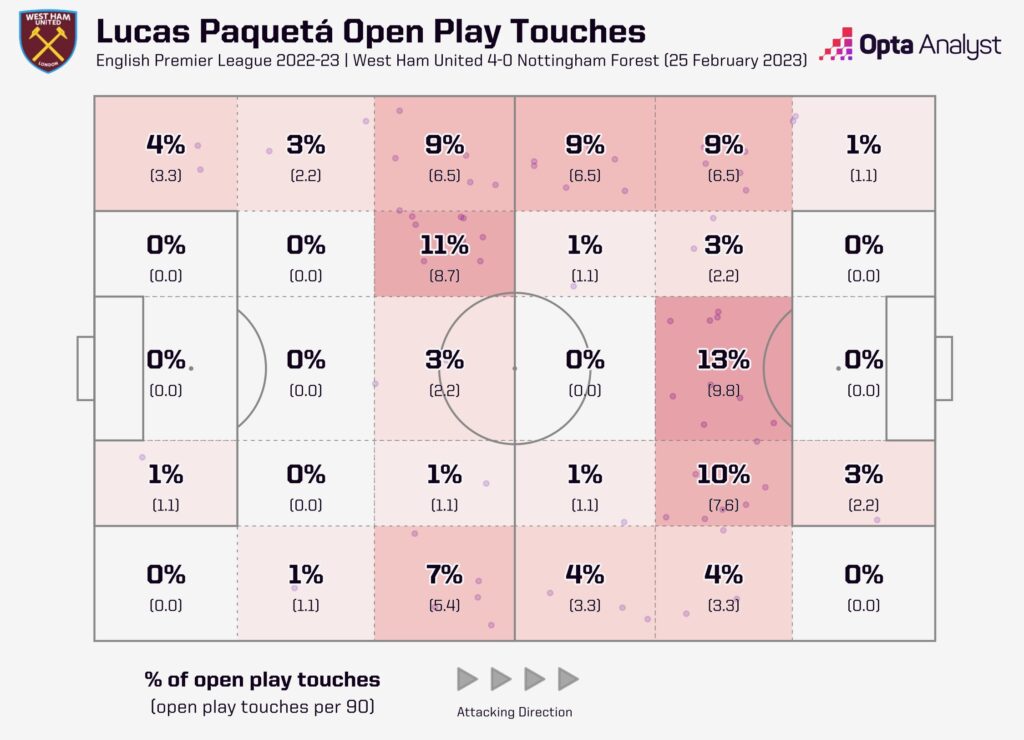
Big defeats at Manchester United and Brighton followed, but in their most recent game, a 1-1 draw with Aston Villa, West Ham recorded a 2.1 xG – registering above two xG in a game for only the fifth time in the Premier League this season.
Throughout 2022-23 Moyes has looked stuck between a rock and a hard place: expected to play more attacking football but anxiously failing to do so, a discomfort symbolised in the jarring use of Paqueta. Now, with his job reportedly on the line, he seems ready to go for it – and Paqueta is taking centre stage.
Roeder’s side rallied impressively in 2002-03 and they were unlucky to go down; they really were ‘too good’ to do so, had it not been such an anomalous season for relegated points tallies. According to Opta’s relegation predictor, there are still seven teams more likely to face the drop than West Ham this time around. There are enough glimpses of hope in recent games, especially with Maxwell Cornet returning from injury, to suggest Moyes’ West Ham can do something similar.
Enjoy this? Subscribe to our mailing list to receive exclusive weekly content. And follow us on Twitter too.
